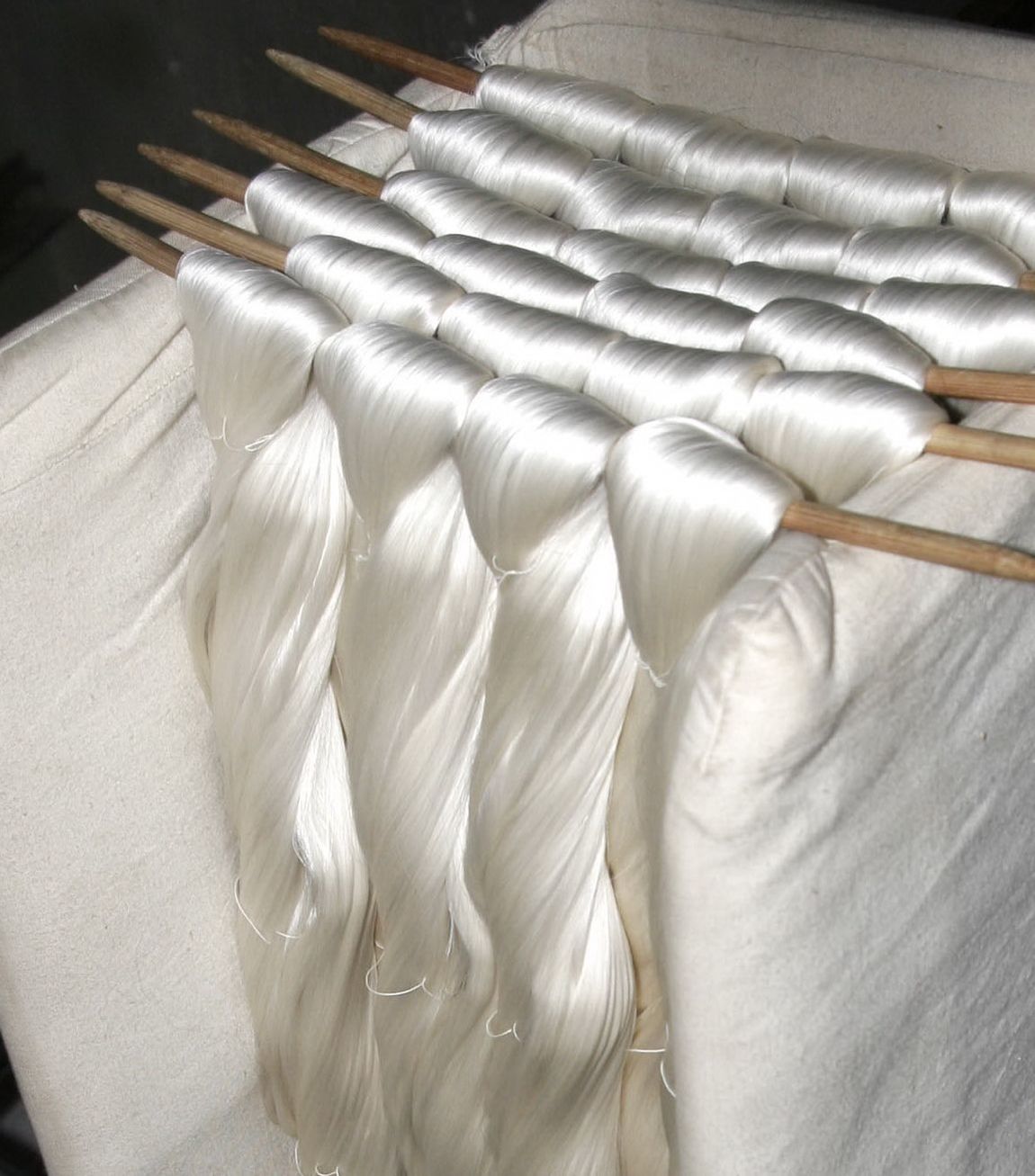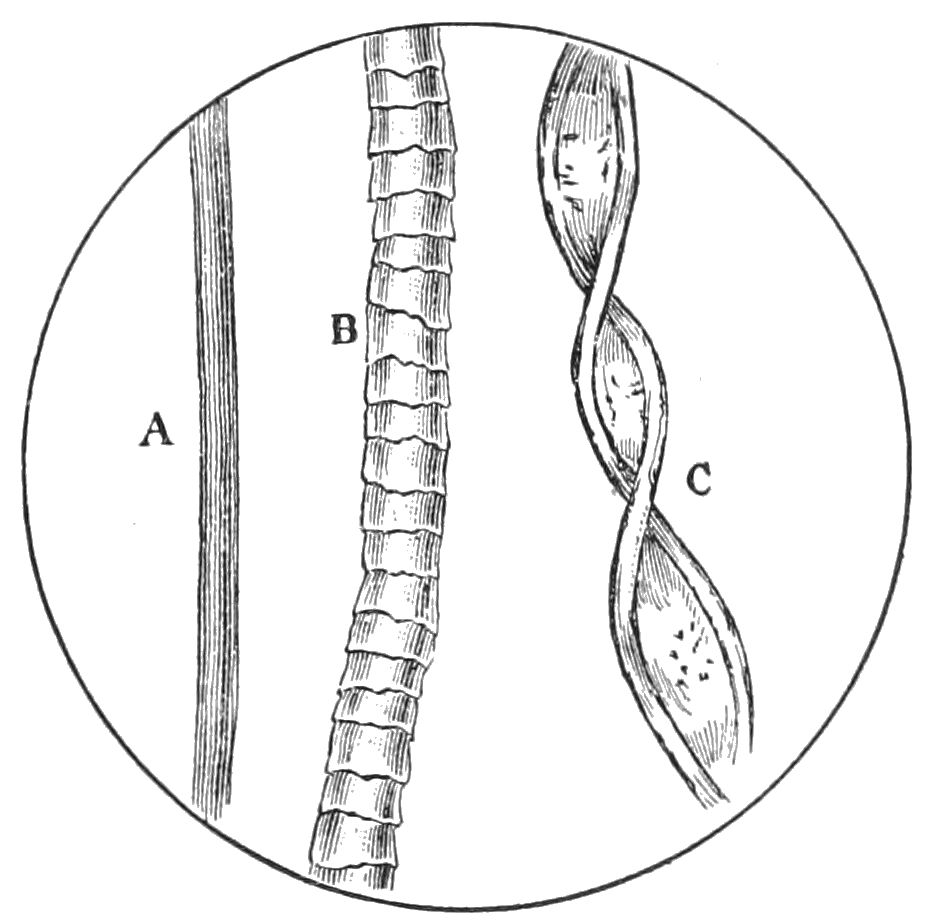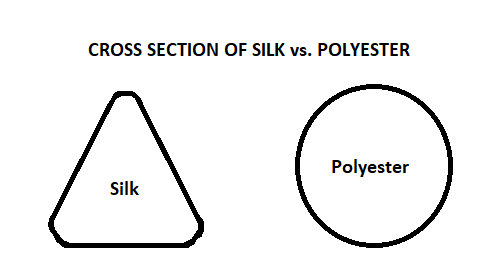LIGHT! The tactile texture of a fabric is how our fingers react to it, but the visible texture of a fabric is how light reacts to it. When light hits something smooth, it bounces off in a straight line and our eyes say "oh, shiny". When light hits something with bumps and angles, the light bounces in various directions as it hits different planes. Then our eyes say "oh, matte". Let's start with a look at natural fibers:
Based on the surface qualities of the fibers, we can easily guess (and a quick trip to our closets should confirm) that silk has the greatest potential to look smooth and shiny, followed by cotton, while wool never does. No matter how straight you pull wool fibers, or how you weave them or how you iron them, they will still have scales that cause the light to bounce off chaotically. What about semi-synthetics? Rayon, when it was invented, was marketed as faux silk. But rayon has striations along its length, so it's ideal to imitate matte silks like crepe de chine or sueded/sandwashed silks. It can also make a very nice satin, but for some reason polyester satins are much more common nowadays. Which brings us to polyester, the shiny fiber. In its microscopic smoothness, it's the closest to silk. Yet, as I said in the introduction, there's still a difference in the quality of the shine. And that difference comes from the cross section: See, silk is a long smooth triangle, while polyester is a long, smooth tube. Polyester is also regular in diameter all along its length, while silk may taper at fiber ends. With polyester, there's no escape from the smoothness! It's too perfect! With silk, there are corners to turn, and the light can be diverted. Somehow, the addition of only three rounded corners is enough to create a softer sheen. Another important difference is mentioned in the that Textile School site I linked to above. The description of the silk fiber is as follows (emphasis mine): "Smooth surface, Structureless, triangular shaped transparent rod". Polyester fibers are not transparent. What does this mean for light? Light can pass through silk fibers, giving the silk fabric a translucent appeal (trans-lucent = letting light pass) and a tendency to pick up on neighboring colors. Polyester doesn't do this. PERFECTION AND VALUE It's interesting how the irregularities of silk fibers now inform our sense of luxury. Through most of human history, perfection was difficult to achieve and consequently valued. Silk was valuable because it was the smoothest and shiniest fabric available. I can easily imagine that if an ancient Roman or Elizabethan saw polyester charmeuse, they'd think it was the best thing ever, worth far more than silk! But post the industrial revolution, perfection is routine. Machines can make things perfectly round, perfectly smooth, so we are not excited by perfection any more. Though silk is no longer the shiniest option, we are drawn to it for its softer luster. We value what technology cannot (yet) replicate. This same dynamic explains why we now value silk dupioni with its slubs, when Victorians would have scoffed at its flaws! SOURCE FOR FIBER DESCRIPTIONS Kadolph, Sarah J. with Anna L. Langford. Textiles, 9th Edition. Prentice Hall, Upper Saddle River, NJ. 2002. Figure 3-3, pp. 20. "Microscopic Appearance of Fibers." Textile School. Posted 12 March, 2018. © 2018 - Truent Systems LLP. Accessed 9/6/2018: https://www.textileschool.com/330/microscopic-appearance-of-fibres/ (Incidentally, you may have noticed that I haven't posted much of my own sewing recently. That's because I'm struggling with time management and haven't been getting projects done. I have a few deadlines coming up, though, and deadlines usually get me moving!)
3 Comments
The Sister
9/24/2018 09:19:52 am
That is very interesting... I rather enjoyed the science behind the light reflection, fiber shape and quality, etc.
Reply
10/13/2020 02:27:40 pm
The Fact Is Clear...Silk's Sheen IS NOT Like "One that"Softly"Smiles At You". In No Way. Silk's Shine is MORE LIKE A WEAK UNENTHUSIASTIC HANDSHAKE. The kind that discourages the other person from doing business or from Socializing with the other"Silk"Person. While Polyester Satin's Shine Is Like a POSITIVE ENTHUSIASTIC CONFIDENT and FIRM HANDSHAKE THAT LET'S THE OTHER PERSON KNOW VERY CLEAR THAT THE OTHER "POLYESTER SATIN"Person is confident and willing to do business or to Socialize with confidence With the other Person. It is clear that protein based Silk has a weak lame and melancholic sheen. NOT Someone Who "Softly Smiles at You" But someone with very low enthusiasm and Joy for Life. While Polyester Satin embodies the enthusiasm and Joy for Life and the Joy of Socializing with others...That is Why it Garners People's Attention because it is a Wonderful Soft Yet Durable Fiber that invites People to come together. Silk on the other hand comes from caterpillar larvae that are KILLED BY BOILING IN ORDER TO EXTRACT THEIR PROTEIN BASED COCOONS. NOT A CELEBRATION OF LIFE AND TECHNOLOGY AT ALL...BUT A BLATANT EXPLOITATION OF OTHER LIFE FORMS. Not So With Humane and Shiny Glossy Happy Joyous Life Affirming Enthusiastic and Optimistic Polyester Satin. Polyester Satin Beats Silk HandsDown everytime for it's Durability,Easier Laundering and Care,Easier to Produce,Affordable for Everyone and It's Truly Lively Joyous Shininess That Lifts People's Spirits and Adds An Intense Festive Joyous Vibration to Any Glamorous or Truly Elegant Event. Our EYES Are Meant To See...To See Bright Wolf Whistling Enthusiastic Beauty. It is Obvious that Silk cheats people by offering a weak lame lackluster sheen. Thank You. And please. Stop The Negative and False description Of Lovely Glamorous Polyester Satin. Stay Safe and Stay Blessed...P.S. Please Do an Article on the Many Benefits and Advantages of Polyester Satin. Much Appreciated. And You'll be Making Our World A More Beautiful Place for All of Good GOD'S Creatures including People. My Apologies for Long Comment. : ) .
Reply
Leave a Reply. |
Karen Roy
Quilting, dressmaking, and history plied with the needle... Sites I EnjoyThe Quilt Index Categories
All
Archives
March 2024
|



 RSS Feed
RSS Feed